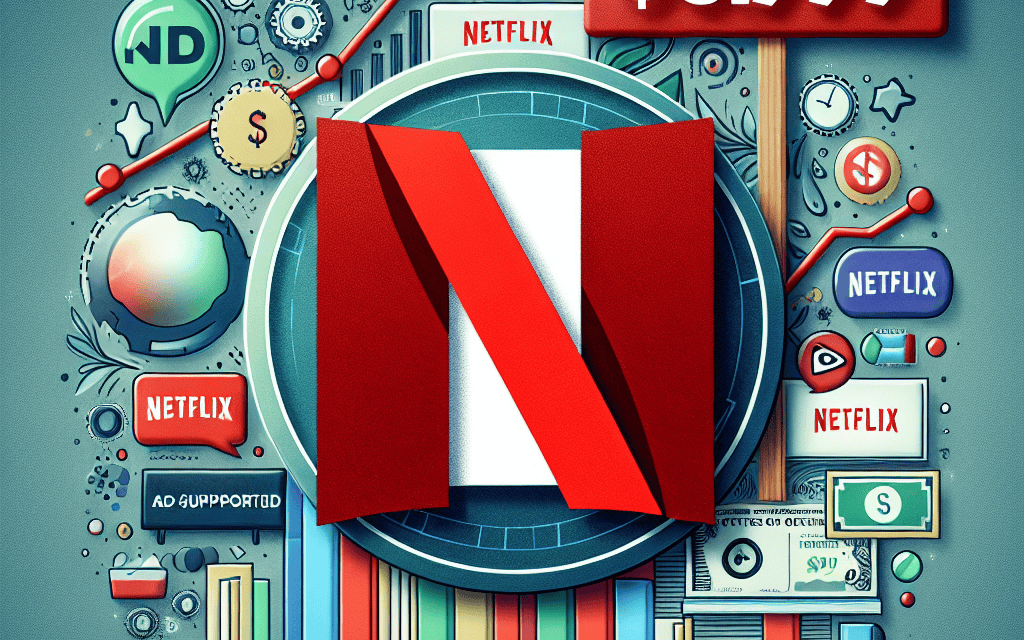“Stream Smart: Netflix Innovates Pricing, Keeping $6.99 Ad-Supported Value in Focus.”
Introduction
Netflix is strategically evolving its pricing model to adapt to the dynamic streaming landscape, with a particular emphasis on its $6.99 ad-supported option. This move reflects Netflix’s commitment to offering diverse subscription tiers that cater to varying consumer preferences and economic conditions. By maintaining and enhancing its ad-supported plan, Netflix aims to attract a broader audience, including cost-conscious viewers, while simultaneously exploring new revenue streams through advertising. This approach not only underscores Netflix’s adaptability in a competitive market but also highlights its dedication to providing value-driven entertainment options for its global subscriber base.
Exploring Netflix’s Pricing Evolution: What It Means for Subscribers
Netflix, a dominant force in the streaming industry, is continuously evolving its pricing strategies to adapt to the ever-changing landscape of digital entertainment. As the company seeks to balance profitability with subscriber satisfaction, it has introduced a variety of pricing tiers, including a $6.99 ad-supported option. This move reflects Netflix’s commitment to offering flexible choices to its diverse audience while also addressing the competitive pressures from other streaming platforms.
The introduction of the ad-supported tier marks a significant shift in Netflix’s traditional business model, which has long been based on ad-free content. By offering a lower-cost option, Netflix aims to attract a broader audience, particularly those who are price-sensitive or new to streaming services. This strategy not only helps in expanding its subscriber base but also provides an entry point for users who might otherwise be deterred by higher subscription costs. Moreover, the ad-supported model opens up a new revenue stream through advertising, which can be reinvested into content creation and platform enhancements.
While the $6.99 tier is an attractive option for many, Netflix is also mindful of maintaining the value of its premium offerings. The company continues to invest heavily in original content, ensuring that subscribers at all levels have access to high-quality programming. This investment is crucial in differentiating Netflix from its competitors, who are also vying for viewers’ attention with their own exclusive content. By maintaining a robust library of original series, films, and documentaries, Netflix reinforces the value proposition of its higher-priced tiers, which offer an ad-free viewing experience and additional features such as higher resolution and multiple device access.
In addition to content investment, Netflix is exploring other ways to enhance subscriber value across its pricing tiers. For instance, the company is experimenting with interactive content and gaming, which could provide unique experiences that set it apart from traditional streaming services. These innovations not only enrich the user experience but also create opportunities for cross-promotion and increased engagement, further justifying the cost of subscription for users.
As Netflix navigates this pricing evolution, it remains attentive to the feedback and preferences of its subscribers. The company regularly conducts market research and analyzes viewing data to understand consumer behavior and preferences. This data-driven approach allows Netflix to make informed decisions about pricing adjustments and content offerings, ensuring that it remains aligned with the needs and expectations of its audience.
Furthermore, Netflix’s pricing strategy is not just about attracting new subscribers but also about retaining existing ones. By offering a range of options, the company provides flexibility for users to switch between tiers as their needs and financial situations change. This adaptability is crucial in maintaining subscriber loyalty in a market where consumers have numerous entertainment choices.
In conclusion, Netflix’s decision to evolve its pricing structure, including the introduction of a $6.99 ad-supported option, reflects its strategic approach to balancing growth and subscriber satisfaction. By offering diverse pricing tiers, investing in original content, and exploring innovative features, Netflix aims to solidify its position as a leader in the streaming industry. As the company continues to adapt to market dynamics, it remains committed to delivering value to its subscribers, ensuring that they have access to a wide array of entertainment options that cater to their preferences and budgets.
The Future of Streaming: Netflix’s Strategy with Its $6.99 Ad-Supported Plan
As the streaming landscape continues to evolve, Netflix remains at the forefront, constantly adapting its strategies to maintain its competitive edge. One of the most significant developments in recent times is the introduction of its $6.99 ad-supported plan, a move that signals a shift in how the company approaches pricing and consumer engagement. This plan not only reflects Netflix’s response to the growing demand for more affordable streaming options but also highlights its commitment to diversifying its revenue streams in an increasingly saturated market.
The decision to offer an ad-supported tier at a lower price point is a strategic maneuver designed to attract a broader audience. In an era where consumers are inundated with a plethora of streaming choices, affordability becomes a crucial factor in decision-making. By introducing a budget-friendly option, Netflix aims to capture price-sensitive viewers who might otherwise opt for competing services. This approach not only expands Netflix’s potential subscriber base but also allows the company to tap into advertising revenue, a stream that has been largely untapped by the platform until now.
Moreover, the $6.99 plan represents a significant shift in Netflix’s traditional business model, which has historically relied on subscription fees alone. By integrating advertisements, Netflix is able to offer a lower price point without compromising its financial stability. This move is particularly timely as the company faces increasing pressure from investors to sustain growth and profitability. The ad-supported model provides a dual benefit: it attracts new subscribers while simultaneously generating additional income through advertising partnerships.
Transitioning to an ad-supported model, however, is not without its challenges. Netflix must carefully balance the integration of advertisements to ensure they do not detract from the user experience, which has been a hallmark of the platform. The company is likely to leverage its vast data analytics capabilities to tailor ads that are relevant and engaging, thereby minimizing potential disruptions. This personalized approach to advertising could set Netflix apart from its competitors, offering a unique value proposition to both viewers and advertisers.
Furthermore, the introduction of the $6.99 plan is indicative of Netflix’s broader strategy to remain agile and responsive to market trends. As consumer preferences shift and new technologies emerge, the company is poised to adapt its offerings accordingly. This flexibility is crucial in an industry characterized by rapid change and fierce competition. By continuously innovating and exploring new pricing models, Netflix demonstrates its commitment to maintaining its leadership position in the streaming sector.
In addition to attracting new subscribers, the ad-supported plan may also serve as a gateway for existing users to explore premium options. As viewers become accustomed to the platform and its content, they may be inclined to upgrade to ad-free plans for an enhanced viewing experience. This potential for upselling further underscores the strategic value of the $6.99 tier.
In conclusion, Netflix’s introduction of a $6.99 ad-supported plan marks a pivotal moment in its evolution as a streaming giant. By embracing a more diversified revenue model, the company is well-positioned to navigate the challenges of a dynamic market while continuing to deliver value to its subscribers. As Netflix refines its approach to advertising and pricing, it sets a precedent for the future of streaming, where flexibility and innovation are key to sustained success.
How Netflix Balances Value and Revenue with Its Ad-Supported Option
Netflix, a pioneer in the streaming industry, has consistently adapted its business model to meet the evolving demands of its global audience. As the company explores new pricing strategies, it remains committed to offering value to its subscribers while optimizing revenue streams. One of the most significant developments in this regard is the introduction of its $6.99 ad-supported option. This move not only reflects Netflix’s adaptability but also highlights its strategic approach to balancing affordability with profitability.
The decision to introduce an ad-supported tier was driven by the need to cater to a broader audience, particularly those who are price-sensitive. By offering a lower-cost option, Netflix aims to attract new subscribers who might have been deterred by the higher price points of its ad-free plans. This strategy is particularly relevant in today’s economic climate, where consumers are increasingly mindful of their spending. The $6.99 plan provides an entry point for these viewers, allowing them to access a vast library of content at a reduced cost, albeit with the inclusion of advertisements.
Moreover, the ad-supported model presents a lucrative opportunity for Netflix to diversify its revenue streams. Advertising has long been a staple of traditional television, and by incorporating it into its platform, Netflix can tap into a new source of income. This approach not only offsets the lower subscription fee but also opens the door to partnerships with brands eager to reach Netflix’s extensive and diverse audience. As a result, the company can maintain its financial health while offering competitive pricing.
Transitioning to an ad-supported model, however, requires careful consideration of the user experience. Netflix has built its reputation on providing seamless, high-quality streaming, and any introduction of ads must be handled delicately to avoid alienating subscribers. To this end, Netflix is likely to implement a limited and strategically placed ad format, ensuring that the viewing experience remains as uninterrupted as possible. By doing so, the company can maintain its brand integrity while still benefiting from the additional revenue generated by advertisements.
Furthermore, the introduction of the ad-supported tier aligns with Netflix’s broader strategy of personalization and customization. By leveraging data analytics, Netflix can tailor advertisements to individual viewer preferences, enhancing the relevance and effectiveness of the ads. This personalized approach not only benefits advertisers but also improves the overall user experience, as viewers are more likely to engage with content that resonates with their interests.
In addition to attracting new subscribers, the ad-supported option may also serve as a retention tool for existing customers. As competition in the streaming industry intensifies, with new entrants and established players vying for market share, offering a range of pricing options can help Netflix retain its subscriber base. By providing a more affordable alternative, Netflix can prevent churn among cost-conscious users who might otherwise switch to competing services.
In conclusion, Netflix’s introduction of a $6.99 ad-supported option represents a strategic effort to balance value and revenue. By offering a lower-cost plan, the company can expand its audience while tapping into the lucrative advertising market. Through careful implementation and a focus on personalization, Netflix can maintain its reputation for quality while adapting to the changing landscape of the streaming industry. As the company continues to evolve its pricing strategies, it remains committed to delivering value to its subscribers and sustaining its position as a leader in the entertainment sector.
Ad-Supported Streaming: A Deep Dive into Netflix’s $6.99 Plan

In the ever-evolving landscape of streaming services, Netflix has consistently been at the forefront, adapting its strategies to meet the demands of a diverse and growing audience. Recently, the company has turned its attention to refining its pricing models, with a particular focus on its $6.99 ad-supported plan. This move comes as part of a broader strategy to balance affordability with quality content delivery, ensuring that Netflix remains competitive in a crowded market.
The introduction of the $6.99 ad-supported option marks a significant shift in Netflix’s approach to content monetization. Historically, the company has relied on a subscription-based model, offering ad-free viewing experiences at various price points. However, as competition intensifies and consumer preferences evolve, Netflix has recognized the need to diversify its offerings. The ad-supported plan is designed to attract cost-conscious viewers who are willing to tolerate advertisements in exchange for a lower subscription fee. This strategy not only broadens Netflix’s potential customer base but also opens up new revenue streams through advertising partnerships.
Transitioning to an ad-supported model presents both opportunities and challenges. On one hand, it allows Netflix to tap into the lucrative advertising market, which has long been dominated by traditional television networks and digital platforms like YouTube. By offering advertisers access to its vast and diverse audience, Netflix can generate significant ad revenue, which can be reinvested into content creation and platform enhancements. On the other hand, the company must carefully manage the integration of ads to ensure that they do not detract from the user experience. Striking the right balance between ad frequency and content quality is crucial to maintaining subscriber satisfaction and loyalty.
Moreover, the $6.99 plan is part of Netflix’s broader effort to address the issue of password sharing, which has been a persistent challenge for the company. By offering a more affordable subscription option, Netflix aims to encourage users who currently share accounts to transition to their own individual plans. This approach not only helps to curb revenue loss from shared accounts but also provides a more personalized viewing experience for each subscriber.
In addition to addressing password sharing, the ad-supported plan aligns with Netflix’s commitment to making its content accessible to a wider audience. As streaming services become an integral part of everyday entertainment, affordability remains a key consideration for many consumers. By offering a budget-friendly option, Netflix can reach viewers who may have been deterred by higher subscription costs, thereby expanding its global footprint.
As Netflix continues to refine its pricing strategy, it remains committed to delivering high-quality content that resonates with audiences worldwide. The company has invested heavily in original programming, spanning a wide range of genres and languages, to cater to diverse tastes and preferences. This commitment to content excellence, coupled with the introduction of the ad-supported plan, positions Netflix to maintain its leadership in the streaming industry.
In conclusion, Netflix’s decision to evolve its pricing strategy by valuing the $6.99 ad-supported option reflects a nuanced understanding of market dynamics and consumer behavior. By embracing an ad-supported model, the company not only enhances its revenue potential but also reinforces its dedication to providing accessible and engaging content. As the streaming landscape continues to evolve, Netflix’s adaptive approach ensures that it remains a formidable player in the industry, poised to meet the challenges and opportunities of the future.
Netflix’s Pricing Strategy: Ad-Supported Plans and Market Impact
Netflix, a dominant force in the streaming industry, is continuously evolving its pricing strategy to adapt to the ever-changing market dynamics and consumer preferences. As part of this evolution, the company has introduced a $6.99 ad-supported plan, which has garnered significant attention. This move is not only a strategic response to the growing competition but also an effort to cater to a broader audience by offering a more affordable option. The introduction of this ad-supported tier marks a significant shift in Netflix’s traditional business model, which has primarily relied on ad-free subscriptions. By incorporating advertisements, Netflix aims to tap into a new revenue stream while simultaneously providing a cost-effective alternative for price-sensitive consumers. This approach reflects a broader industry trend, as other streaming giants have also embraced ad-supported models to diversify their offerings and maximize their market reach.
Moreover, the $6.99 plan is designed to attract a segment of the audience that may have been hesitant to subscribe due to cost considerations. By lowering the entry barrier, Netflix hopes to expand its subscriber base and increase its market penetration. This strategy is particularly relevant in regions where disposable income is limited, and consumers are more price-conscious. Furthermore, the ad-supported plan allows Netflix to compete more effectively with other streaming services that offer similar options, thereby leveling the playing field in an increasingly crowded market. In addition to attracting new subscribers, the ad-supported plan provides Netflix with valuable data on viewer preferences and behavior. This data can be leveraged to enhance content recommendations, improve user experience, and optimize advertising strategies. By understanding what resonates with its audience, Netflix can tailor its content offerings to better meet the needs and expectations of its diverse subscriber base.
However, the introduction of advertisements raises questions about the potential impact on user experience, a hallmark of Netflix’s brand identity. To address these concerns, Netflix is likely to implement a carefully curated advertising strategy that minimizes disruption and maintains the quality of its content. By ensuring that ads are relevant and seamlessly integrated into the viewing experience, Netflix can mitigate potential drawbacks and preserve its reputation for delivering high-quality entertainment. As Netflix continues to refine its pricing strategy, it must also consider the implications for its existing subscriber base. While the ad-supported plan offers an attractive option for new users, it is essential to ensure that current subscribers do not feel alienated or undervalued. To this end, Netflix may explore additional features or benefits for its ad-free plans, thereby reinforcing the value proposition for its loyal customers.
In conclusion, Netflix’s decision to introduce a $6.99 ad-supported plan represents a strategic evolution in its pricing strategy, aimed at expanding its audience and diversifying its revenue streams. By offering a more affordable option, Netflix can attract price-sensitive consumers and compete more effectively in a crowded market. At the same time, the company must carefully balance the introduction of advertisements with the need to maintain a positive user experience and uphold its brand identity. As Netflix navigates this complex landscape, its ability to adapt and innovate will be crucial in sustaining its position as a leader in the streaming industry. Through thoughtful execution and a commitment to understanding its audience, Netflix can successfully leverage its ad-supported plan to drive growth and enhance its market impact.
The Economics of Streaming: Netflix’s Approach to Affordable Plans
In the ever-evolving landscape of digital entertainment, Netflix continues to adapt its pricing strategies to maintain its competitive edge while catering to a diverse audience. As the streaming giant navigates the complexities of the market, it has become increasingly clear that offering a range of subscription options is crucial to its success. Among these, the $6.99 ad-supported plan has emerged as a significant component of Netflix’s pricing strategy, reflecting the company’s commitment to affordability without compromising on quality.
The introduction of the ad-supported tier marks a strategic shift for Netflix, which historically relied on ad-free subscriptions. This move is not merely a response to competitive pressures but also an acknowledgment of changing consumer preferences. As streaming services proliferate, viewers are presented with a plethora of choices, making cost a critical factor in their decision-making process. By offering a lower-priced option, Netflix aims to attract budget-conscious consumers who might otherwise be deterred by higher subscription fees.
Moreover, the ad-supported plan allows Netflix to tap into a new revenue stream. Advertising, long a staple of traditional television, offers a lucrative opportunity for streaming platforms to monetize content beyond subscription fees. This dual-revenue model not only enhances Netflix’s financial stability but also enables the company to invest in diverse and high-quality content, thereby enriching the viewing experience for all subscribers.
Transitioning to a model that includes advertising, however, requires careful consideration of the user experience. Netflix has been meticulous in ensuring that ads are integrated seamlessly into the platform, minimizing disruption to viewers. By leveraging data analytics, the company can deliver targeted advertisements that align with individual viewer preferences, thereby enhancing engagement and satisfaction. This personalized approach not only benefits advertisers but also ensures that the ad-supported plan remains appealing to subscribers.
In addition to the ad-supported option, Netflix continues to offer its traditional ad-free plans, recognizing that a one-size-fits-all approach is no longer viable in today’s diverse market. By maintaining a tiered pricing structure, Netflix can cater to a wide range of consumer needs and preferences. This flexibility is particularly important as the company expands its global footprint, where economic conditions and consumer expectations can vary significantly.
Furthermore, Netflix’s commitment to affordability is underscored by its investment in original content. By producing a vast array of shows and films across genres and languages, Netflix ensures that subscribers receive value for their money, regardless of the plan they choose. This content diversity not only attracts new subscribers but also fosters loyalty among existing ones, as viewers are more likely to remain with a service that consistently delivers fresh and engaging content.
As Netflix continues to refine its pricing strategy, it remains focused on balancing affordability with quality. The $6.99 ad-supported plan is a testament to this approach, offering a cost-effective entry point for new subscribers while maintaining the high standards that have become synonymous with the Netflix brand. By evolving its pricing model in response to market dynamics and consumer preferences, Netflix is well-positioned to sustain its growth and continue its leadership in the streaming industry. Through strategic innovation and a commitment to customer satisfaction, Netflix exemplifies how adaptability and foresight can drive success in a competitive digital landscape.
Consumer Reactions to Netflix’s Evolving Pricing and Ad-Supported Model
As Netflix continues to dominate the streaming landscape, its evolving pricing strategy has become a focal point for both consumers and industry analysts. The introduction of a $6.99 ad-supported option marks a significant shift in Netflix’s approach, aiming to cater to a broader audience while maintaining its competitive edge. This move has sparked a variety of reactions from consumers, reflecting a complex interplay of expectations, preferences, and concerns.
Initially, the introduction of an ad-supported tier was met with skepticism by some long-time subscribers who have grown accustomed to the ad-free experience that Netflix has traditionally offered. For these users, the presence of advertisements represents a departure from the uninterrupted viewing that has been a hallmark of the platform. However, Netflix’s decision to offer this lower-priced option is not without its strategic merits. By providing a more affordable entry point, the company aims to attract cost-conscious consumers who may have been deterred by the rising subscription fees of its ad-free plans.
Moreover, the $6.99 tier is designed to appeal to a demographic that is increasingly accustomed to ad-supported content, as seen with platforms like Hulu and Peacock. For these viewers, the trade-off between cost and occasional advertisements is a familiar one, and the lower price point may be an attractive proposition. This strategy not only broadens Netflix’s potential subscriber base but also aligns with the broader industry trend of offering diverse pricing models to accommodate varying consumer preferences.
In addition to expanding its audience, Netflix’s ad-supported model presents an opportunity to generate additional revenue streams. By leveraging its vast user data, Netflix can offer targeted advertising, which is highly valued by marketers seeking to reach specific demographics. This capability enhances the platform’s appeal to advertisers, potentially offsetting any revenue loss from subscribers opting for the cheaper plan. Consequently, this dual approach of subscription and ad revenue could bolster Netflix’s financial performance in an increasingly competitive market.
Despite these potential benefits, some consumers express concerns about the implications of an ad-supported model on content quality and user experience. There is apprehension that the introduction of advertisements could lead to a shift in content priorities, with a focus on producing shows and movies that appeal to advertisers rather than purely creative endeavors. Additionally, the integration of ads raises questions about how seamlessly they will be incorporated into the viewing experience, with users wary of disruptive or poorly timed interruptions.
Nevertheless, Netflix has assured its audience that the ad-supported tier will maintain the platform’s commitment to high-quality content. The company has emphasized that advertisements will be limited in frequency and duration, aiming to minimize disruption and preserve the overall viewing experience. This reassurance is crucial in maintaining consumer trust and ensuring that the ad-supported model complements rather than detracts from Netflix’s brand identity.
In conclusion, Netflix’s evolving pricing strategy, highlighted by the introduction of a $6.99 ad-supported option, reflects a nuanced response to shifting consumer expectations and market dynamics. While the move has elicited mixed reactions, it underscores Netflix’s commitment to innovation and adaptability in a rapidly changing industry. As the company navigates this transition, its ability to balance affordability, content quality, and user experience will be pivotal in shaping consumer perceptions and sustaining its leadership in the streaming sector.
Q&A
1. **What is Netflix’s current ad-supported plan price?**
Netflix’s ad-supported plan is priced at $6.99 per month.
2. **Why is Netflix considering evolving its pricing strategy?**
Netflix is exploring pricing changes to better align with market demands, increase revenue, and attract a broader subscriber base.
3. **How does the ad-supported plan benefit Netflix?**
The ad-supported plan allows Netflix to tap into advertising revenue while offering a lower-cost option to attract price-sensitive customers.
4. **What are potential changes Netflix might consider in its pricing strategy?**
Potential changes could include introducing new pricing tiers, adjusting existing plan prices, or offering more flexible subscription options.
5. **How does the $6.99 plan compare to Netflix’s other subscription options?**
The $6.99 ad-supported plan is the most affordable option, with other plans offering ad-free viewing at higher price points.
6. **What is the target audience for the ad-supported plan?**
The ad-supported plan targets budget-conscious consumers who are willing to watch ads in exchange for a lower subscription cost.
7. **How might evolving pricing impact Netflix’s market position?**
Evolving pricing could enhance Netflix’s competitiveness by attracting diverse customer segments and increasing overall subscriber growth.
Conclusion
Netflix’s strategy to evolve its pricing structure while maintaining its $6.99 ad-supported option reflects a dual approach to cater to diverse consumer segments and maximize revenue. By offering a lower-cost, ad-supported tier, Netflix aims to attract price-sensitive customers and expand its subscriber base, particularly in competitive markets. This move also allows the company to tap into advertising revenue, diversifying its income streams beyond traditional subscription fees. As the streaming landscape becomes increasingly crowded, Netflix’s pricing evolution is a strategic effort to balance affordability with profitability, ensuring it remains a dominant player in the industry while adapting to changing consumer preferences and market dynamics.





